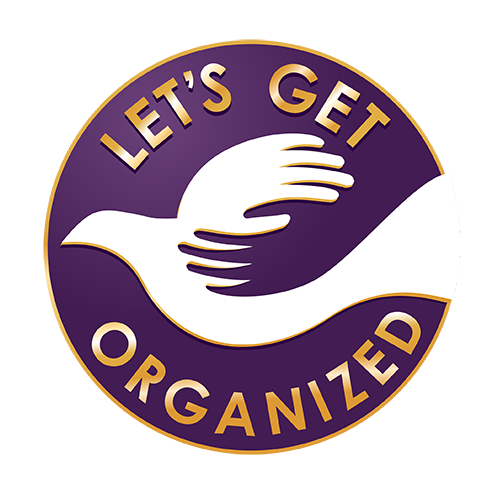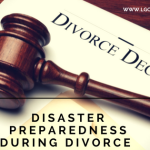Disaster Preparedness During Divorce
So you’re somewhere in the divorce process – contemplating it, navigating it, or recovering from it – and a disaster strikes. What do you do now?
The best answers would be: 1) you and the kids pick up your Grab & Go kit and head to your pre-arranged safe place or 2) you hunker down to shelter in place, comforted by the knowledge that you planned ahead and were prepared.
How many of us can honestly say we’re prepared for a disaster, whether or not we are in the middle of a divorce? Probably not that many. Our daily lives are busy, and we don’t often think about the remote possibility of things not staying exactly as they are today. Some may even say that going through a divorce is itself a disaster. There is so much to do and think about; one more thing could easily set us over the edge.
Just how remote is the possibility of experiencing a disaster? Not very. A disaster could be created by nature, such as an extreme weather condition that causes physical destruction to communities and prolonged power outages. It could be man-made, such as acts of violence or terrorism, that prevent unimpeded communication, travel, and access to information. Organizing for disaster preparedness at any time, including during a divorce, makes good practical sense for keeping oneself and one’s children safe. Including a disaster preparedness plan in the ultimate divorce agreement can avoid much confusion and heartache in the event of an emergency.
“What do I need to do to prepare for a possible disaster?”
I’m glad you asked. There are many aspects to disaster preparedness, but here we’ll talk about preserving important documents and home contents, family communication, and emergency provisions.
Documents and home contents
When going through the divorce process, you’re already reviewing and organizing your important documents and home contents. It’s a short step from there to organizing for a natural or man-made disaster.
- Update beneficiary and emergency contact information on important documents, like life insurance policies, wills, financial accounts, and doctors’ records, as soon as you know you’re getting divorced.
- Make an extra copy or backup of the vital information you’re gathering to provide to your legal team and other trusted advisors. Send this copy to an out-of-state family member or friend (or maintain an online backup far away from your geographic location), in case a disaster strikes your local banks (i.e. safe deposit box) and municipal authorities (for replacement documents) as well as your own home.
- Make hard copies of wallet or purse contents and vital documents in a water-tight, vacuum-sealed plastic bag (like a Space Bag). This is handy in case you have to evacuate quickly and show immediate information to first responders.
- Include proof of all family members’ identities (drivers’ licenses, birth certificates, passports, and social security cards)
- Include vital contacts (extended family’s contact information, employers, banks, insurance agents, utility companies, and the department of motor vehicles)
- Include important codes (PINs, passwords, user codes, etc.), and other essential information, such as prescriptions.
- You can, of course, digitize your documents, include a flash drive or CD/DVD of electronic versions of these documents in the bag, keep one in your safe deposit box, and send backups to your off-site storage contacts.
- A divorcing couple with children should each do this for themselves and both should have their children’s information.
- Create a home inventory list (or video the contents), and include the list (or video) in your bag. You’re already cataloging your personal belongings in preparing for a divorce, so this part is easy.
- What’s the first thing people answer when asked what they would grab in an emergency? Photos. Taking the time now to digitize physical snapshots and organize digital photos can save great heartache later. Photos of children can be preserved if each member of the couple has a copy.
Family communication
Yes, communication between divorcing spouses can be strained. However, in an emergency, safety comes first. Many divorcing couples agree that their children’s welfare is primary. Family members may be in different places, like work, school, or even out of the country, when a disaster strikes. Cell phone, text, and email service may not be available. Having a plan in place in case of a disaster can alleviate much of the uncertainty and anxiety of not being able to see, talk to, or gain access to your children or other family members. Again, each partner of the divorcing couple should have a plan, especially in the case of shared custody of children. Here are a few suggestions for how to create a family communication plan:
- Identify a safe meeting place where all family members can reunite if an emergency hits your home, e.g. a fire.
- In case of a major power outage, have a low-tech phone available and use a landline to get in touch with family members.
- Have a family contact who lives out of town. If local phone service is overloaded due to volume, long distance lines may still be open.
- Know the disaster plans of employers, schools, and daycare centers.
Emergency provisions
We can’t foresee every possible disaster scenario, but we can have supplies prepared, just in case. Prepare for both: having to leave home with little notice and sheltering in place for a few days. Disaster-preparedness experts recommend having enough supplies for 72 hours. It’s a good idea to have disaster survival kits prepared in your home, office, and car.
Leaving home with little notice
Assemble a Grab & Go kit for each family member. Label the kits with each family member’s name and keep them with your emergency supplies (see Sheltering in Place below). Tailor your kits’ contents to your family’s needs, but make sure to include:
- Battery-powered or hand-cranked radio
- Flashlight and extra batteries
- Whistle
- Water bottle
- High-protein, high-energy food bars
- Change of clothes
- Lightweight emergency blanket
- First aid kit and prescription medications
- Travel size toiletries
- Hand sanitizer and small bottle of bleach
- Copies of essential documents (see above)
- Family photograph
- Extra set of car, home, and safe deposit box keys
- Cash ($300-$500 should be plenty)
- Pen, pencil, paper
- Toilet paper
Sheltering in Place
Designate a centralized “safe room” in your house and equip it with emergency supplies. You may need to live in it for a few days, so make sure that it is appropriately sized to fit your family and supplies you may need. Include:
- See contents of Grab & Go kits
- A 3-day supply of non-perishable food, baby food, and pet food, as applicable
- Manual can opener
- Water – one gallon per person, per day
- Paper/plastic products – plates, cups, utensils, paper towels, toilet paper, garbage bags
- Extra clothing and footwear
- Bedding
- Tools
- First aid kit
- Important documents
- Rotary or push-button telephone to use with a land line – not a cell phone or a phone dependent on electricity
- Your Grab & Go kits
The American Red Cross has Emergency Preparedness Kits available for purchase on its website at http://www.redcrossstore.org. Note: at the time of this writing, some items were sold out.
Source consulted: Organize for Disaster, Judith Kolberg, 2005.[/fusion_text][/fusion_builder_column][/fusion_builder_row][/fusion_builder_container]




